
The Araceae are a family of monocotyledonous flowering plants in which flowers are borne on a type of inflorescence called a spadix. The spadix is usually accompanied by, and sometimes partially enclosed in, a spathe or leaf-like bract. Also known as the arum family, members are often colloquially known as aroids. This family of 140 genera and about 3,750 known species is most diverse in the New World tropics, although also distributed in the Old World tropics and northern temperate regions.

Heinrich Wilhelm Schott was an Austrian botanist well known for his extensive work on aroids (Araceae).

Anthurium is a genus of about 1,000 species of flowering plants, the largest genus of the arum family, Araceae. General common names include anthurium, tailflower, flamingo flower, and laceleaf.
Carlephyton is a genus of three species in the family Araceae, all endemic to Madagascar. The three species in this genus are seasonally dormant tubers. The leaves are cordate with a sub-marginal collective vein. The fine venation is reticulate. There are usually one to three leaves. The petiole sheath is short. Inflorescences are typical aroids with a spathe and spadix. It has no sterile appendix and its flowers, usually one to three, are unisexual. The spathe is not constricted and the lower part is persistent in anthesis. The berries tend to be orange-red. They are known to grow in tropical deciduous forests on limestone or basalt or in rock crevices.

Callopsis is a monotypic genus from the plant family Araceae and has only one species, Callopsis volkensii. This plant forms a creeping rhizome and has cordate-ovate leaves that are medium green and glaborous. The inflorescence is typical of the family Araceae, with a white spathe and yellow spadix. The spadix is shorter than the spathe and its male and female flowers are separated shortly.

Aridarum is a genus of flowering plants in the family Araceae. All of the known species in this genus are rheophytic and are endemic to the Island of Borneo. The plant is aquatic and has willow-shaped leaves that are able to take strong currents without sustaining damage.

Stylochaeton is a genus of flowering plants in the family Araceae that is endemic to Africa. Stylochaeton are rhizomatous with hastate leaves. Flowering in this genus is said to be quite uncommon. Stylochaeton is the sole genus in the tribe Stylochaetoneae.

Aroideae is a subfamily of flowering plants in the family Araceae. It is the largest subfamily in Araceae and consists of about 72 different genera, and 2,300 species. Many Aroideae have spiny pollen grains without a sporopollenin outer exine layer and lacking an aperture.
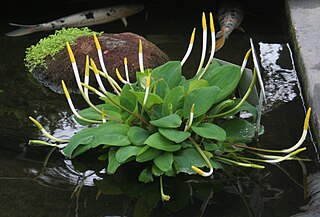
Orontium aquaticum, sometimes called golden-club, floating arum, never-wets or tawkin, is a species of flowering plants in the family Araceae. It is the single living species in the genus Orontium, which also contains several extinct species described from fossils. O. aquaticum is endemic to the eastern United States and is found growing in ponds, streams, and shallow lakes. It prefers an acidic environment. The leaves are pointed and oval with a water repellent surface. The inflorescence is most notable for having an extremely small almost indistinguishable sheath surrounding the spadix. Very early in the flowering this green sheath withers away leaving only the spadix.

Pothoidium is a monotypic genus of flowering plants in the family Araceae. The single species that comprises the genus is Pothoidium lobbianum. It is native to Maluku, Sulawesi, the Philippines, and Lan Yü Island of Taiwan.
Amydrium is a genus of flowering plants in the family Araceae that is native to Southeast Asia, southern China, and New Guinea.
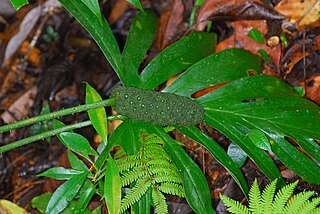
Lasia is a genus of flowering plants in the family Araceae, native to Asia and New Guinea. The genus contains only two known species, Lasia spinosa and Lasia concinna. Lasia was believed to be a monotypic genus until 1997 when a wild population of Lasia concinna was discovered in a farmer's paddy field in West Kalimantan, Indonesia. The farmer had been growing them for their edible young leaves. This species of Lasia had been known of previously only from a single specimen at the Bogor Botanic Gardens, formally described in 1920. Prior to 1997, the specimen was believed to have been a hybrid between Lasia spinosa and Cyrtosperma merkusii. The subsequent discovery by Hambali and Sizemore led to the realization that it was in fact a distinct species.
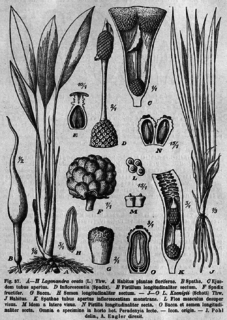
Lagenandra is a genus of flowering plants in the family Araceae. It is endemic to the Indian Subcontinent. The genus is similar to Cryptocoryne, but can be distinguished from it by its involute vernation. Cryptocoryne on the other hand exhibit convolute vernation.
Gorgonidium is a genus of flowering plants in the family Araceae. It is native to South America. The spathes tend to be purple and the fruits are black.
- Gorgonidium beckianumBogner - Bolivia
- Gorgonidium bulbostylumBogner & E.G.Gonç - Bolivia
- Gorgonidium cardenasianum(Bogner) E.G.Gonç - Bolivia
- Gorgonidium intermedium(Bogner) E.G.Gonç - Peru
- Gorgonidium mirabileSchott - Bolivia
- Gorgonidium striatumHett., Ibisch & E.G.Gonç
- Gorgonidium vargasiiBogner & Nicolson - Peru
- Gorgonidium vermicidum(Speg.) Bogner & Nicolson - Bolivia, northern Argentina
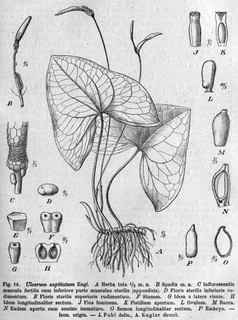
Ulearum is a genus of flowering plants in the family Araceae. It contains two known species, both native to South America. Ulearum is similar to Callopsis, but Callopsis is found only in Africa and so its relation is uncertain.
- Ulearum donburnsiiCroat & Feuerst. 2003 - Ecuador
- Ulearum sagittatumEngl. 1905 - Loreto region of eastern Peru, Acre State in western Brazil
Schottarum is a genus of flowering plants belonging to the family Araceae.
Schottariella is a monotypic genus of flowering plants belonging to the family Araceae. The only species is Schottariella mirifica.
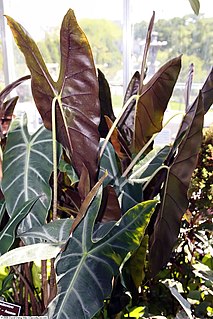
Alocasia longiloba is a species of flowering plant in the family Araceae. It is the namesake of a species complex. The complex has a widespread distribution; Guangdong, Hainan, and southern Yunnan in China, mainland Southeast Asia, and western and central Malesia.

Anthurium clavigerum is a species of plant in the genus Anthurium. Native to Central and South America, it ranges from Honduras to central and western Brazil. This epiphyte has distinctive leaves that are deeply lobed and sometimes sinuous edges. The main stem can be several meters long and the palmate leaves can be 2 meters across, giving it the largest foliage of any Anthurium in Central America.













